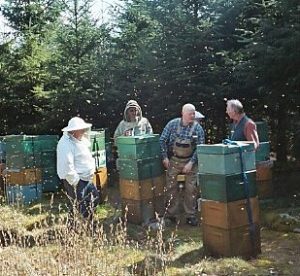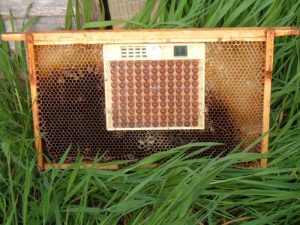The Rosneath Dark Bee breeding project no longer operates but the story of its beginnings and later development make interesting reading. There is much to learn from this venture.
The Rosneath peninsula lies between Loch Long and Gareloch opposite Helensburgh
The project was started in 2007 by Ben Bellamy and myself with the help of the other 9 beekeepers living and keeping bees on the peninsula. Ben Bellamy and I visited Denmark on a beekeeping trip organised by the Scottish Beekeeping Association and then Apimondia in Dublin where we went on to visit various bee breeding projects in Ireland
In Denmark we observed that by selective breeding it was possible to produce nice productive gentle bees. We noticed that the local Danish beekeepers when opening their hives did not wear gloves or veils. The bees were not Apis mellifera mellifera , however after visiting some bee breeding projects in Southern Ireland we observed again gentle bees but this time the Irish beekeepers were breeding Amm.

In Southern Ireland the Galtee bee breeding group used the natural geography of a valley for their bee improvement with rings of defence around the breeding site. Ben thought the Rosneath peninsula which is 8 miles long and about a mile wide would make a good site for bee breeding being surrounded by water on three sides. Most of the population of about 3,000 lives on the coastal fringe. There are only small farms with a few sheep and cows and very little arable land. Most of the central area is owned by the MOD as are the surrounding areas. To the north are high mountains helping to isolate the area.
As you can see from the map the majority of the population is located at the southern end of the peninsula.
At the initial meeting of the bee breeding group we got a lot of help from John Tyler from Largs, who was at that time the Scottish BIBBA representative.
We set up the following aims for the group which were:
- Produce a Unique Queen ID Code
- Standardise Hive Records
- Produce a Stud Book
- To Check the Morphometry
- Select Suitable Breeding Stock
- Find an Isolated Mating Site
Samples were collected from the 35 colonies located on the peninsula. We gave them a unique code to help identify the source and started to check the morphometry to assess what type of bees we had on the peninsula. At that time we used the Beemorph program for wing morphometry and found 80% of colonies showing Amm features.
At the time we were inexperienced in interpreting the results but a few of the BIBBA committee, who were on their way to the SBA conference in Inverness, called in to see us and they got quite excited when they saw the results and encouraged us to start a breeding program. The problem was we were inexperienced beekeepers with few skills and little specialized equipment so Ben and I went out to look for training courses to expand our skills.
The group dynamics also changed. Some of the beekeepers left the area and some others ran out of enthusiasm but most were inexperienced and had difficulty scoring the bee characteristics when examining their colonies. Those who continued also had difficulty in using the Beemorph program and we found there was a lot of operator error in the wing morphometry results.
It was also at that time when there were a lot of new beekeepers starting to keep bees (due to ‘save the bees’ campaigns) and as we could not supply them with suitable stock they were given bees through our local association which were ‘local’ bees but often hybridised.
It was apparent to Ben and myself that we required further training to increase our skills if the group was to progress. We attended a BIBBA meeting at Stoneleigh where the BIBBA members were talking about a new and improved wing morphometry program designed by a young researcher called Adam Tofilski.
It was not until I attended the SICAMM conference in Aviemore (2009) that I met Peter Edwards and Roger Patterson who both took time to train me in the new wing morphometry program call DrawWing
The advantage of this program was it was quicker to analyse wings as the relevant points were placed by the program therefore eliminating a lot of the operator error we saw with the Beemorph program. Another problem we encountered was the skill required for the production of queens by grafting or using the Nicot cupkit/Jenter system and mini nucs. It was after attending the Queen Rearing and Bee Breeding day in Fife (2010) held at the Dunfermline & West Fife Apiary and led by Terry Clare of BIBBA that the final pieces of the jigsaw came together. We then had moderate success with the Nicot cupkit system and mininucs and were able to provide stock to other beekeepers on the Peninsula.

We decided that since a few years had elapsed from our first survey of the colonies and that a lot of the original beekeepers in the group had either given up beekeeping or had moved off the peninsula and more colonies had been brought onto the peninsula it was worth repeating the survey but using the new DrawWing software. We managed to obtain samples from most of the colonies on the peninsula.
We discovered that the previous colonies that had given good Amm results had been affected by the hybridized bees that were brought into the area. Where we once had about 80% of pure Amm a few years ago we were down to about 20% Amm. The strongest area for Amm was to the north of the peninsula where there were fewer beekeepers.
It was important at this time to try and set up an isolated mating area preferably at the north end of the peninsula but most of that area was MOD land with restricted access. So we entered into negotiations with the MOD and though the local MOD officials were keen we ran into a lot of red tape from MOD Estates in London. However we discovered that the MOD were keen to set up a local community nature reserve which so happened to be in the north of the peninsula.
We then joined forces with the Peaton Hill community nature reserve and obtained an area in the reserve for bee breeding. It also benefited the Peaton Hill community nature reserve and the MOD, who still owned the land. The reserve won an environmental award in its second year for MOD reserves in the UK and brought the Silver Otter Award for the first time to Scotland. Part of the submission by the reserve was the work we were doing with conserving Scottish Native bees. It also helped to obtain funding as the reserve got a grant of £10,000 from SNH to help put in infrastructure to the reserve. This indirectly helped the native bees conservation work as it improved access.
Although we had a more isolated mating site it was not ideal as it was at the top of a hill and was quite wet especially in the winter. Early spring forage was also poor. It was not a good site to keep bees over winter and in our first year on the site we lost a few colonies due to the damp conditions and chalk brood that was also a problem. Unfortunately the group gradually disbanded. Some moved away and ill health prevented others from keeping bees. I moved my best Amm colonies to a site off the peninsula and near to Loch Lomond and tried to maintain the Amm strains as best I could. I have since moved to the Moray region and have taken my best four Amm colonies with me, so if I can find an isolated site may still be able to produce Amm queens.
Looking back, the group started with a lot of enthusiasm however the lack of knowledge and experience in the group did not help to keep momentum. To get the relevant knowledge, experience and access to an isolated site took time and in some cases years to obtain, however was a lot of fun and I personally learned a lot about honey bees on the journey.
Jim McCulloch
